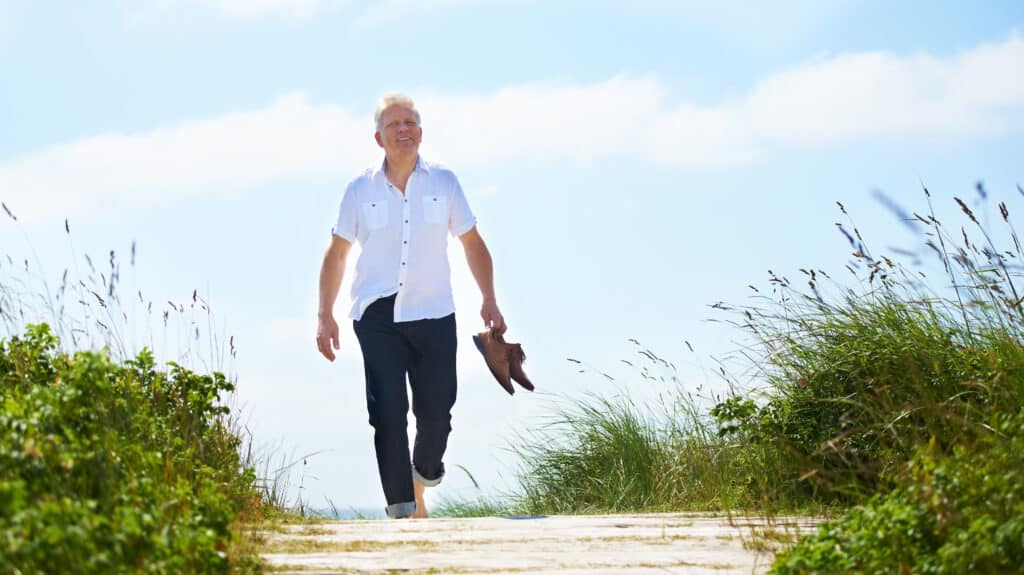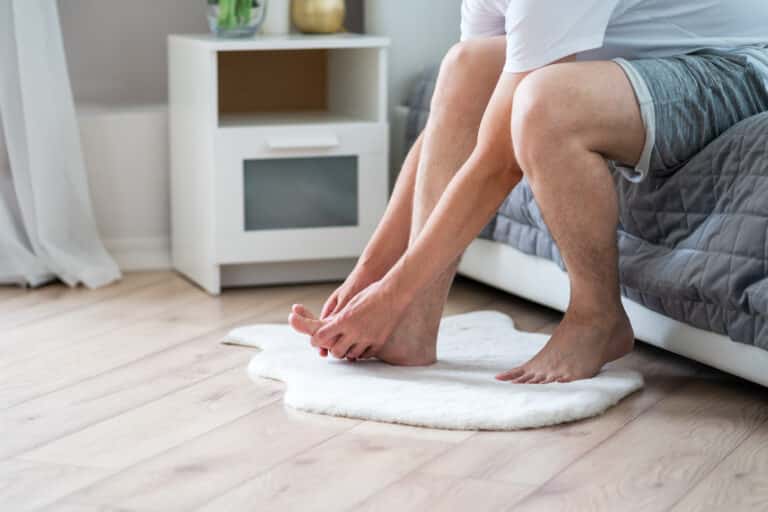Have you ever wondered how gout affects different body parts? Are you curious about what you can do to address the challenges of a gout diagnosis? Contrary to popular belief, gout isn’t only a disease of the feet; it can also affect the hands, knees, and shoulders, among other areas.
According to the National Institute of Health, gout affects 13.3% of men and 6.6% of women by age 75, making it the most common inflammatory arthritis among older adults. This underscores the importance of addressing gout before it gets worse.1
Gout can be a formidable challenge, especially for active adults seeking to maintain mobility and overall health. In this article, we’ll explore the impact of gout on various body locations and provide practical care tips to keep you moving.
What is Gout?
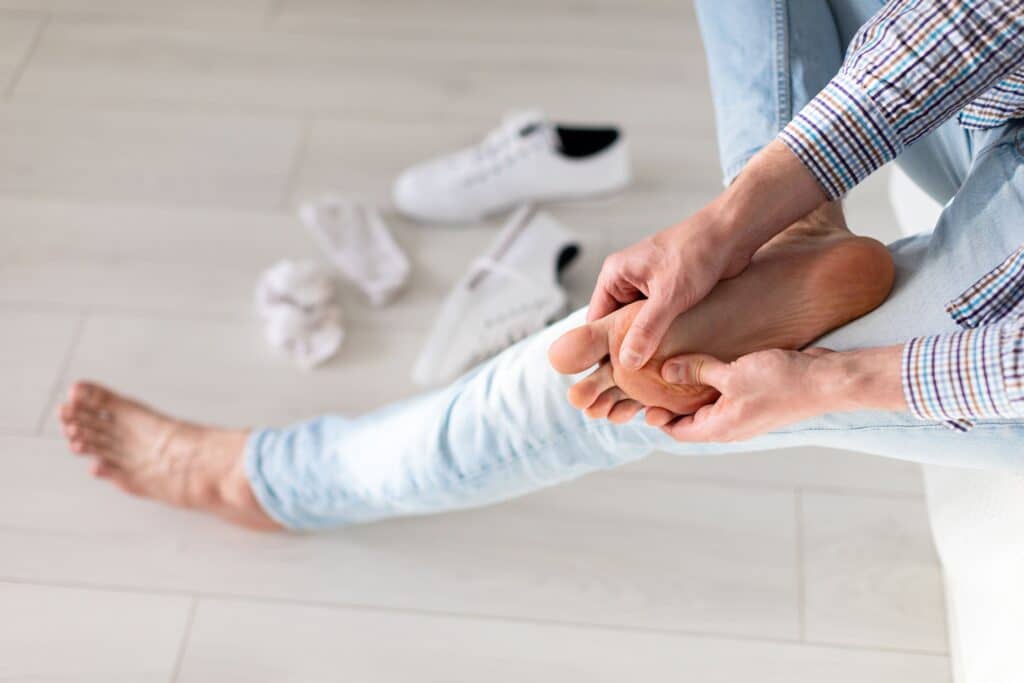
Gout, a type of inflammatory arthritis, emerges when the body accumulates high uric acid levels. Uric acid is a byproduct of the breakdown of a chemical compound known as purines found in certain foods and beverages, most notably alcohol—especially beer—and red meat.
Typically uric acid dissolves in the blood and passes through the kidneys. However, when the body produces too much uric acid or the kidneys can’t eliminate it efficiently, uric acid crystals can form in the joints, leading to gout.
These crystals can result in joint irritation that can often be severe and debilitatingly painful.
Why Gout Often Appears in the Hands & Feet
Understanding gout’s anatomical and physiological nuances helps shed light on why certain joints, especially those toward the end of the limbs, are more susceptible to the impact of this condition.
Gout’s bias for joints at the extremities, such as the toes and fingers, can be attributed to a few factors.
First, the solubility of uric acid, a key player in gout, is influenced by temperature. Joints located further away from the body’s core, where temperatures are lower, provide an environment that encourages the crystallization of uric acid.
Secondly, these peripheral joints also experience increased mechanical stress, contributing to the deposition of uric acid crystals.
However, this does not mean gout is solely located in those areas. Rather it can rear its ugly head in joints throughout the body.
How Gout Impacts Mobility
Imagine trying to take a step or climb stairs when every movement in your affected joints sends a sharp pain through your arms or legs. This is the reality for many older adults grappling with gout. The discomfort can be particularly debilitating, affecting day-to-day activities and overall quality of life.
The hallmark of gout is intense pain and swelling in the affected joints, which can translate to significant challenges in mobility, especially for older adults who are at increased risk for other age-related limitations.
Gout-irritated joints become inflamed, causing discomfort and limiting range of motion. When your joints are stiff and painful, any movement becomes daunting, and the risk of falls increases. As a result you could be at risk for muscle strength loss due to immobility.
Let’s look at how this condition uniquely presents in different body areas.
Gout in the Toe Joints

Gout is often an issue in the toe joints, with the big toe being a frequent target. The big toe’s lower temperature is ideal for uric acid crystal formation compared to other joints.
Because the toes are the most distant extremities from the heart, it takes longer for blood flow to make its way to the toe, impacting circulation and temperature. As a result, individuals with gout often experience excruciating pain, swelling, and redness in their toes.
The pain associated with gout in the toes can be relentless, hindering a person’s ability to walk comfortably. Even simple activities like putting on shoes or walking short distances can become arduous tasks.
As mentioned previously, you are more likely to become sedentary if you cannot walk comfortably, leading to other health problems, like decreased endurance and muscle weakness.2
Relative Rest, NSAIDs & Ice
To alleviate pain and enhance mobility, it is first and foremost essential to rest until the pain and swelling become somewhat manageable. However, if you have an active job or hobbies and spend a lot of time on your feet, it may not always be possible to rest completely.
Relative Rest is a concept recommended in many physical therapy practices for gout and other similar conditions. This practice encourages you to be active in ways that allow the affected joints to be less active than during normal routines.
For example, if you like to walk, hike, or jog, it may be helpful to try swimming or cycling, which involve considerably less weight-bearing for the toes and feet.
It’s also a good idea to talk to your doctor about starting a cycle of non-steroidal anti-inflammatory drugs (NSAIDs) like Ibuprofen alongside icing the joint to help quell inflammation.
Physical Therapy Recommendations for Toe Gout
In my physical therapy practice, I often recommend that my patients incorporate specific low-intensity exercises into their routine that can make a significant difference. Consider the following exercises:
- Toe Stretches: Gently stretch the toes by flexing and extending them, using manual assistance, or simply using your toe muscles. If possible, try to perform this range of motion exercise in a pain-free range.
- Non-Weightbearing Ankle Exercise: Exercises like ‘ankle pumps’ in which you repeatedly point and flex the ankle can help to bring circulation to the feet and toes.
- Low-Impact Exercises: Engage in activities like swimming or cycling that don’t exert excessive pressure on the toe joints. This can help to re-introduce movement back into your body without aggravating the affected joints.
It’s crucial to recognize that everyone’s experience with gout is unique. Tailoring care to individual needs, considering factors such as pain tolerance and overall health, can enhance the effectiveness of the chosen exercises.
Gout in the Knees

It goes without saying that the knee joint plays a fundamental role in daily activities. If you have experienced gout in the knee, no doubt you understand how much of a burden this painful condition can become and how it can limit your ability to move normally.
Like the toes, the knees are weight-bearing joints susceptible to accumulating uric acid crystal deposits. Gout in the knees can lead to inflammation, pain, and swelling, significantly affecting mobility and the ability to perform routine tasks.
Individuals with gout in the knees often find it difficult to perform activities that involve bending or putting weight on the knees.
Simple actions like walking, climbing stairs, or standing up from a seated position can become limited and painful. It is often more comfortable for those with gout in the knees to keep their legs straight rather than bent.
Physical Therapy Recommendations for Knee Gout
Managing gout in the knees also involves a combination of inflammation and pain management with NSAIDs and ice alongside targeted strengthening exercises. If you have knee gout, consider incorporating the following exercises into your routine:
- Low-impact knee exercises: Focus on activities like stationary cycling or water aerobics that minimize stress on the knee joints.
- Range of Motion Exercises: Perform gentle stretches to maintain flexibility and reduce knee stiffness. Focus on bending your knee as much as possible without too much pain exacerbation.
- Edema massage: Attempting to move some of the swelling out of your knee joint area may be helpful to increase the range of motion. You can use light pressure to push the fluid accumulated in your knee joint up toward your thigh to decrease edema in the knee.
Ensuring the overall health of your knees is vital. Proper care, including exercises and lifestyle adjustments, can contribute to managing gout flares and promoting long-term knee health.
Gout in the Hands
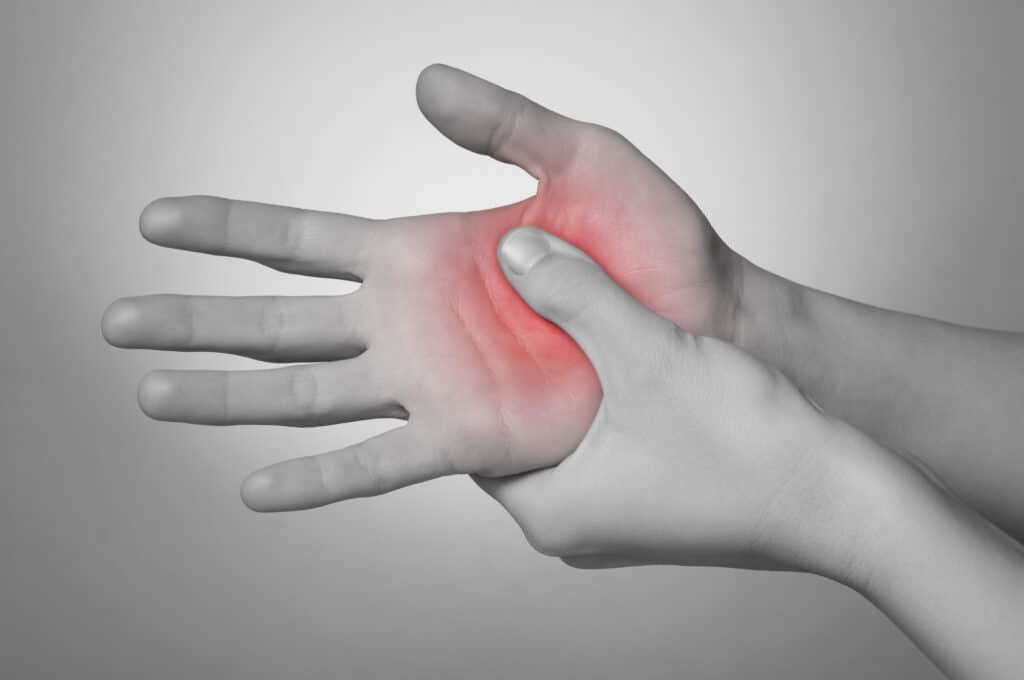
The hand, wrist, and finger joints are not immune to the impact of gout, and the presence of uric acid crystals can lead to discomfort and reduced functionality.
Similar to the toes, the hands are another area in which temperatures can be lower than more proximal areas of the body. Older adults may find tasks like gripping objects or even buttoning a shirt challenging.
For many seniors, hand gout can present unique challenges. The loss of hand strength and dexterity can affect daily activities and diminish the enjoyment of hobbies and social interactions. It may even impact the ability to use silverware, feed yourself, or tie your shoes if severe enough.
Physical Therapy Recommendations for Hand & Finger Gout
Incorporating some hand exercises into your routine can be instrumental in managing gout-related hand pain. Consider the following exercises:
- Hand Stretches: Gently stretch (extend and flex) the fingers and wrists to enhance flexibility. Repetitively performing basic hand stretches can also help move some of the fluid from the fingers back into circulation to decrease swelling.
- Grip-Strengthening Exercises: Use handgrip exercises or stress balls to improve hand strength. If you’re looking for a simple at-home technique, try rolling and firmly squeezing a small towel.
While exercises can contribute to hand health, it’s also essential to prudently integrate these practices into daily life alongside activity moderation and rest.
Simple modifications in activities can go a long way in managing hand-related gout symptoms. It is necessary to avoid overuse of these joints and rest when you can to decrease pain and swelling.
Often, I will recommend using adaptive tools like specialized handles for containers or jar openers to my patients when symptoms flare up to limit overuse and avoid pain. Once symptoms have calmed down, I encourage my patients to space out their daily activities and chores so they do not overly exert their hands.
Care Strategies for Multiple Gout Locations
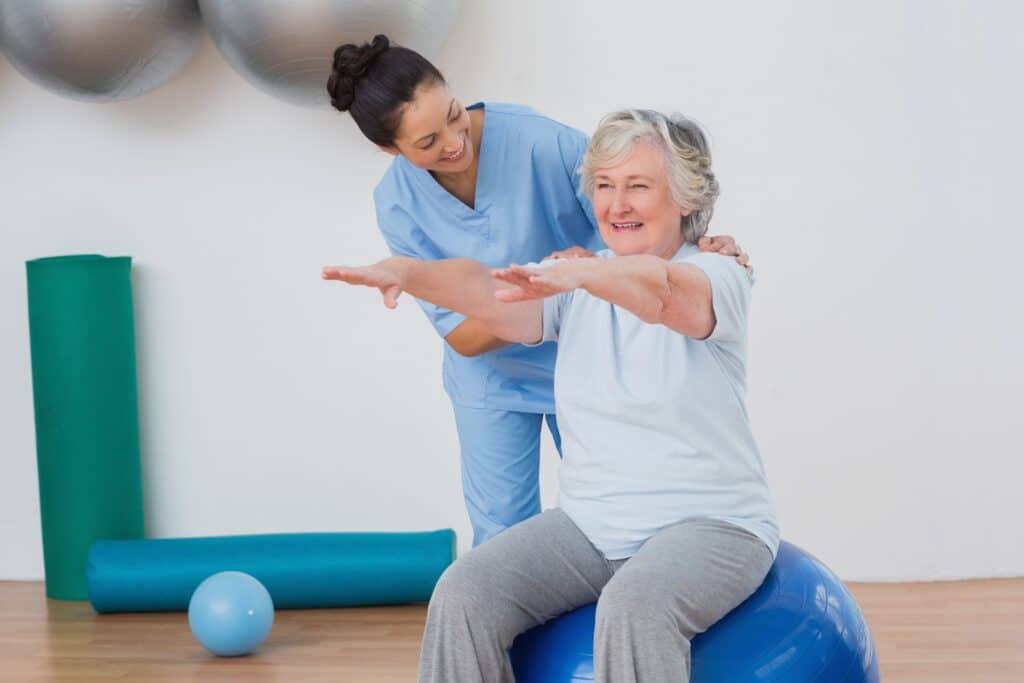
A holistic approach to care is vital for individuals dealing with gout in various body locations simultaneously.
Managing gout in several areas demands a comprehensive and personalized care plan. Recognizing that each individual’s experience is unique, a one-size-fits-all approach may not be practical, so it’s best to discuss your gout symptoms with your primary care provider or physical therapist.
However, certain guidelines can help you manage gout symptoms until you can talk to your doctor. Whether you’re dealing with gout in the toes, knees, hands, or a combination, the following tips can help you cope with gout flares.
Medication Optimization
Focus on using anti-inflammatory medications effectively, both for immediate relief during acute attacks and for long-term management to prevent future flares. This includes understanding the appropriate timing, dosage, and potential side effects of medications like NSAIDs, colchicine, and urate-lowering drugs.
Dietary Modifications
Implement a diet that reduces purine intake, decreases uric acid levels, and lessens gout flare-ups. Encourage the consumption of foods rich in antioxidants and anti-inflammatory properties alongside the reduction of alcohol, particularly beer and fructose-rich foods.
Activity Modification
Tailor physical activities to minimize stress on affected joints, incorporating exercises like swimming or cycling that are less taxing. Balancing physical activity with adequate rest periods is crucial, especially during flare-ups, to prevent aggravation of symptoms.
Pain Management Techniques
Employ a range of physical therapy techniques tailored to each affected area. To review:
- For toes, focus on gentle toe stretches and non-weight-bearing ankle exercises.
- For knee gout, incorporate range-of-motion exercises and low-impact strengthening activities.
- Hand gout management might include hand stretches and grip-strengthening exercises.
Remember that rest is crucial for recovering from gout flare-ups.
Lifestyle Adjustments
Identify and modify personal and environmental factors that may trigger gout symptoms. This includes stress management, maintaining a healthy weight, and ensuring adequate hydration to facilitate uric acid excretion.
Key Takeaways
Before we conclude our exploration of gout and its impact on various body locations, let’s recap the key insights from each section:
- Gout is a multifaceted condition affecting various joints beyond the feet, requiring a nuanced understanding of its impact on different body parts.
- Prevalent in older adults, gout management is crucial for maintaining mobility and quality of life.
- The disease stems from uric acid overproduction or under-excretion, leading to joint crystal formation, causing pain and inflammation.
- Gout significantly hampers mobility, necessitating a balance between activity and rest to manage pain and prevent further joint damage.
- Managing gout effectively involves a combination of pharmacological treatments, dietary adjustments, physical therapy, and lifestyle changes, each tailored to the individual’s unique symptoms and health status.
- Personalized care strategies are paramount in effectively managing gout across multiple body locations, emphasizing the importance of understanding each individual’s unique experience with the disease.
Summary
Gout, an inflammatory arthritis caused by uric acid crystal buildup, affects various body parts like the hands, knees, and toes, particularly in older adults. Its impact on mobility and daily activities can be significant, necessitating a comprehensive management approach.
This includes medication optimization, dietary changes, low-impact exercises, and lifestyle adjustments. Tailoring these strategies to individual needs is essential in effectively managing gout across different body locations, underscoring the importance of personalized care and proactive health management.
Remember, you are not alone in this journey. Whether navigating gout yourself or supporting a loved one, reaching out to healthcare professionals for guidance and support is crucial. Here’s to embracing mobility, prioritizing joint health, and enjoying a vibrant and active lifestyle at every stage of life.
References
- Burke, B. T., Köttgen, A., Law, A., Windham, B. G., Segev, D., Baer, A. N., Coresh, J., & McAdams-DeMarco, M. A. (2015). Physical Function, Hyperuricemia, and Gout in Older Adults. Arthritis care & research, 67(12), 1730–1738. https://doi.org/10.1002/acr.22648
- Grassi, W., & De Angelis, R. (2011). Clinical features of gout. Reumatismo, 63(4), 238-245.

